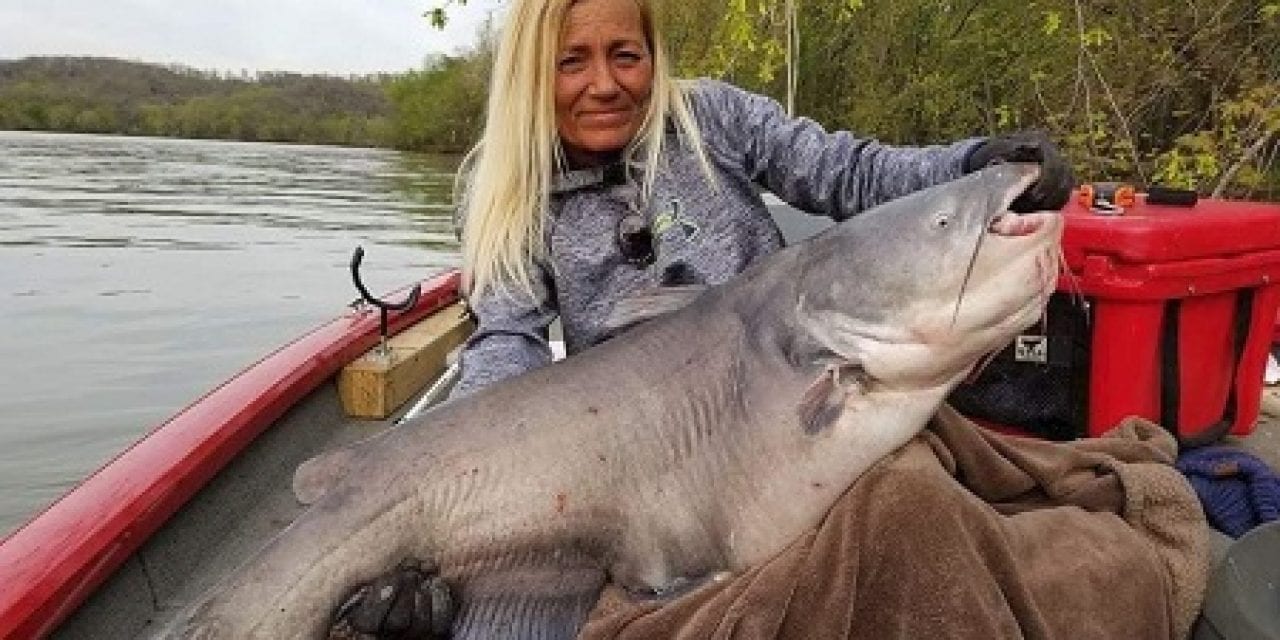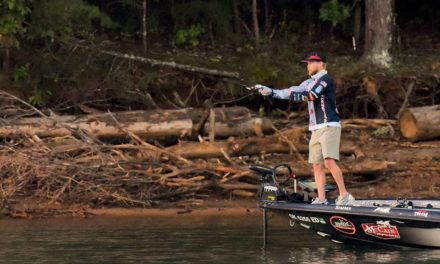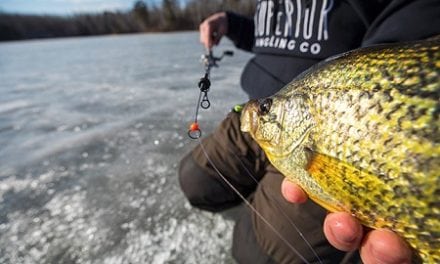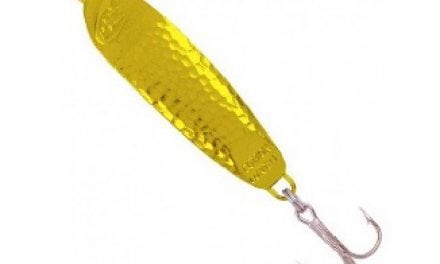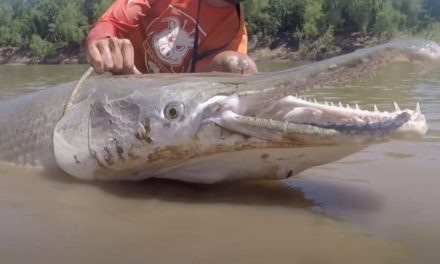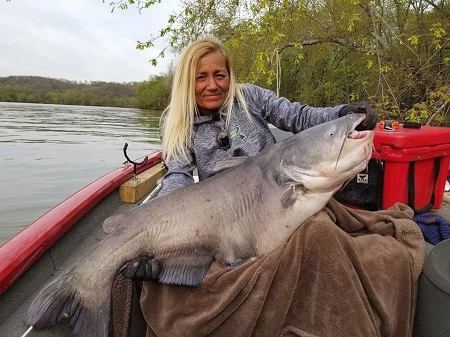
When winter rolls around and brings her colder weather patterns to town, Paula Smith’s thoughts migrate toward fooling some big blue catfish. The Waverly, TN resident knows from experience that catfish get more predictable as the temperatures fall and that is a plus for anglers. Regardless of where or when you fish, a key factor is being able to locate the fish and then present them with the food they want.
Smith fishes mostly around Humphreys County She ended 2018 with a bang when she landed her personal best 88-pound blue catfish on Kentucky Lake. She uses the December 30, 2018 catch as an example of the wintertime fish she likes to target. She and her husband, Ken Smith, a TWRA Officer, also frequent the Duck and Cumberland River when they are fishing for big catfish.
“Ken plays a huge role in my fishing. We fish some tournaments together when he isn’t busy being a game warden,” joked Smith. “He has taught me a lot about studying fish and what to look for. Mostly Ken just fishes for fun. When he’s too busy I go out on my own.”
Given her passion for catching trophy catfish and the knowledge learned from her husband and others, Paula has become an informed student of the whiskered critter and the waters that she fishes.
She describes the Duck River as smaller and shallower. It averages less than 25 feet. It is also clearer than the Cumberland River. She considers it mainly an anchor fishing opportunity.
“I really like fishing the Duck in the winter,” offered Paula. “Especially when it has that aqua color. It just seems like the fish bite better in water that’s cleaner.”
The Cumberland is deeper and muddy with a lot more areas to fish. It is still mostly anchor fishing but she also drift-fishes some. It is characterized by woody structure and rocky terrain with holes as deep as 75 to 80 feet.
Kentucky Lake, where she landed her 88-pounder, is part of the Tennessee River System. It ranges in depth from shallow to 100 feet deep holes. It offers a lot more opportunities to fish and is characterized by more boat ramps that make it very accessible for anglers.
“The Tennessee River is great for fishing where the mouths of creeks come in,” suggested Smith. “If the conditions are good, with steady current flow, the fish gather around the creek mouths. If the current is strong, I like to fish the edges of creek mouths and into the bays where the fish are not as stressed. From my experience, if they have been fighting the heavy, strong current, they tend to hold up in smaller deep holes to get out of the heavy flow.”
When the catfish scatter out in the summer, she recommends suspend drifting to cover more water. When the water gets cold that’s when she targets the big blues in their winter lairs.
“Cold weather moves catfish to their deep wintering holes,” offered Smith. “And strong currents will push them into creek mouths and eddies where baitfish are present. Once temperatures reach the low 40’s the blues head for the deepest areas in the lake or river. They might even be hugging the bottom because it is warmer. It is not unusual to catch big cats in cold water that are covered in mud. All fish are cold blooded and in cold water, they don’t need to feed as often because it takes longer to digest the food. Nevertheless, they will still feed all winter long.”
“Blue catfish migrate to these deep wintering holes, instead of scattering as they do in warmer months,” instructed Smith. “They often congregate in large numbers where they can be found and targeted during the winter months.”
Smith often looks for smaller isolated deep holes in an area that includes some shallow water. She gives an example of an area in the river or lake that averages 15 feet but includes a hole that might be 20 to 25 feet deep. She says such a hole is even better if the deep part contains some wood or other structure. She uses sonar to identify the water depth and accompanying structure.
“One of the hardest things I’ve had to learn is using sonar to locate catfish,” suggested Smith. “Using it correctly helps identify catfish migration patterns and consequently lets me know when and where to fish seasonally during changing conditions.”
“I also use the Asian carp to find the catfish,” continued Smith. “The catfish will often be found in the same areas that hold the carp. I think it might be because the same water conditions attract both species. We use sonar to locate concentrations of carp because the catfish are hard to see when the carp are present. I caught my personal best 88-pound blue cat in just such an area.”
Circle hooks are a must on Smith’s terminal tackle because they allow the fish to set the hook when the rod loads up. All the angler has to do is start reeling. They are also conservation friendly, usually hooking the fish in the corner of the mouth instead of being swallowed.
“My tackle consists of 30- to 40-pound test mono mainline,” instructed Smith. “I tie a Carolina rig by sliding a 3- to 8-oz slip sinker up the mainline before connecting to a swivel. The amount of weight depends on the current. I use enough weight to keep the bait on the bottom. I add a 10- to 25-inch hook leader with an 8/0 to 10/0 circle hook. When I bait up, I want the hook to be well exposed.”
Smith uses two words to describe her choice of bait—fresh and local. She urges anglers to use bait that is found naturally in the area. And use fresh bait (not frozen) if at all possible. She does subscribe to the big-bait, big-fish theory, but more so in the warmer parts of the year. In cold water, she does like to downsize.
“The best bait is what is found locally in the area,” said Smith. “On Kentucky Lake gizzard shad is the predominant shad species catfish feed on in the winter. Drum, bluegill, skipjack, stripes and other local baits will work. The size of the bait depends on what you’re fishing for and what the catfish will take on any given day. Always try different size baits, but the main thing to remember is that large blue catfish feed almost exclusively on fish, the fresher the better. A large shad, say a 1/2 pound, can be cut in half and make two baits. The same is true for large bluegill. We’ll also try a large head or large cut chunk to see if the cats are preferring larger baits. A trial and error strategy is good because every day is different.”
Paula likes to stick primarily to fishing isolated cover like rocks and trees in the main river channel. She uses precision anchoring to be able to get her bait as close as possible to the targeted cover.
“First I locate either catfish or cover using the depth finder,” explained Smith. “Then I position the boat directly upstream from the targeted area. The anchor is set and the boat is released slowly downstream to a point where the bait can be cast directly over the cover.”
Once the bait is placed the waiting game begins. Most anglers agree that patience is a virtue when it comes to fishing but Smith offers some sound advice for winter fishing.
“Catfish don’t move as much in colder months,” coached Smith. “If you’ve been fishing a spot for 15 to 30 minutes without a bite, it’s time to move on. Sometimes that move may be measured only in feet, but other times it may require moving to a completely new location with different characteristics.”
“Winter fishing is most definitely worth it,” concluded Smith. “I love fishing year-round because the excitement and adrenaline rush of a big cat is just pure awesomeness. But in the winter the fish are stacked closer together where they can be targeted by savvy anglers who study the habits of the fish in all conditions. Pay attention to current, water temperature, depth, etc. I was told when I was younger that you can’t catch fish if your bait isn’t in the water! Just keep putting in the time and never give up and you will be successful too.”
By Ron Presley
Note: This story first appeared in the FREE February 2019 issue of CatfishNow Digital Magazine. You can visit the website at www.catfishnow.com and read all previous issues. While you are there you can subscribe for free and never miss an issue of CatfishNow.
Related articles:
- Shakespeare Fishing – Beginner’s Guide to Catfish Fishing
- Vexilar Video – Ice Fishing Today – Ice Team U Catfish
- Ice Fishing For Catfish With Ice Team
The post Cold Water Blue Cats appeared first on OutDoors Unlimited Media and Magazine.

